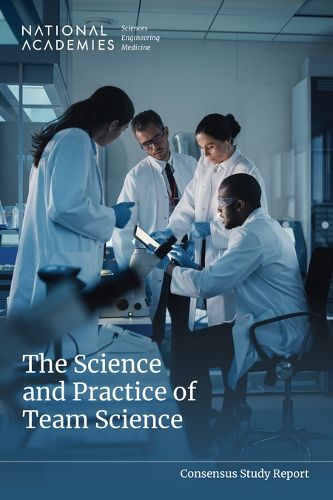Readings Newsletter
Become a Readings Member to make your shopping experience even easier.
Sign in or sign up for free!
You’re not far away from qualifying for FREE standard shipping within Australia
You’ve qualified for FREE standard shipping within Australia
The cart is loading…






As scientific problems grow more complex and interdisciplinary, the need for effective, collaborative, and context-sensitive research teams has never been greater. The Science and Practice of Team Science presents an updated, evidence-based roadmap for supporting science teams across a wide variety of domains, disciplines, and organizational structures.
This new report from the National Academies builds on a decade of learning since the landmark Enhancing the Effectiveness of Team Science report. It examines how evolving forces - including digital innovation, global disruptions, and the rise of virtual collaboration - are reshaping the way scientific teams form, function, and deliver results. From small interdisciplinary groups to large-scale, distributed multiteam systems, today's science teams require flexible strategies tailored to their goals, environments, and challenges.
The Science and Practice of Team Science outlines adaptable practices that enhance team dynamics and productivity across all phases of research - from development to implementation to translation. These include the use of team charters, psychological safety, communication strategies, and project management. This report also emphasizes the role of technology in enabling collaboration while cautioning that tools must be intentionally deployed to support accessibility, training, and integration with workflows.
Table of Contents
Front Matter Summary 1 Introduction 2 Review of Current Science of Team Science 3 Best Practices 4 Institutional and External Supports for Team Science 5 Evaluating Team Science 6 Forward-Looking Research Recommendations and Infrastructure Needs Appendix A: Committee Biosketches Appendix B: Team Science Background Appendix C: High-Functioning Science Teams Appendix D: Sampling of Survey-Based Team Assessments Appendix E: Glossary
$9.00 standard shipping within Australia
FREE standard shipping within Australia for orders over $100.00
Express & International shipping calculated at checkout
Stock availability can be subject to change without notice. We recommend calling the shop or contacting our online team to check availability of low stock items. Please see our Shopping Online page for more details.
As scientific problems grow more complex and interdisciplinary, the need for effective, collaborative, and context-sensitive research teams has never been greater. The Science and Practice of Team Science presents an updated, evidence-based roadmap for supporting science teams across a wide variety of domains, disciplines, and organizational structures.
This new report from the National Academies builds on a decade of learning since the landmark Enhancing the Effectiveness of Team Science report. It examines how evolving forces - including digital innovation, global disruptions, and the rise of virtual collaboration - are reshaping the way scientific teams form, function, and deliver results. From small interdisciplinary groups to large-scale, distributed multiteam systems, today's science teams require flexible strategies tailored to their goals, environments, and challenges.
The Science and Practice of Team Science outlines adaptable practices that enhance team dynamics and productivity across all phases of research - from development to implementation to translation. These include the use of team charters, psychological safety, communication strategies, and project management. This report also emphasizes the role of technology in enabling collaboration while cautioning that tools must be intentionally deployed to support accessibility, training, and integration with workflows.
Table of Contents
Front Matter Summary 1 Introduction 2 Review of Current Science of Team Science 3 Best Practices 4 Institutional and External Supports for Team Science 5 Evaluating Team Science 6 Forward-Looking Research Recommendations and Infrastructure Needs Appendix A: Committee Biosketches Appendix B: Team Science Background Appendix C: High-Functioning Science Teams Appendix D: Sampling of Survey-Based Team Assessments Appendix E: Glossary